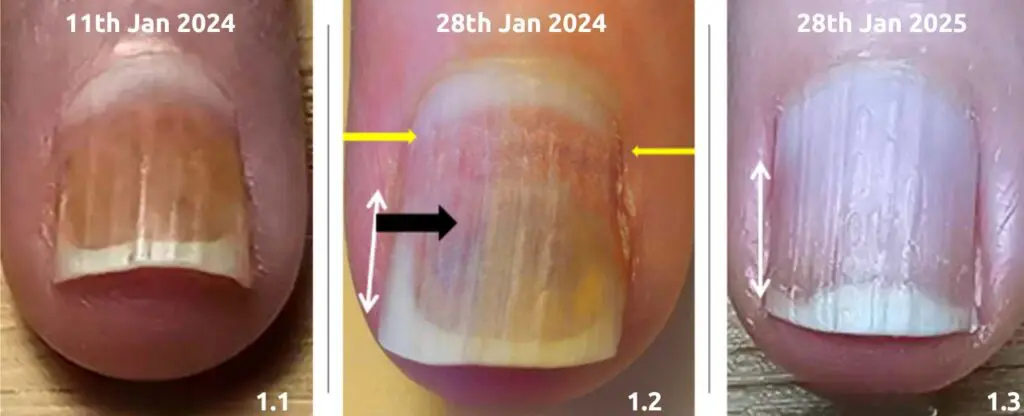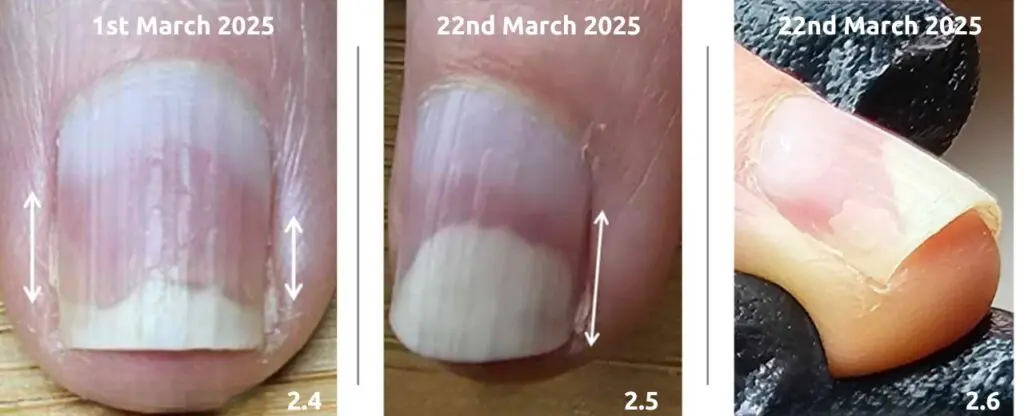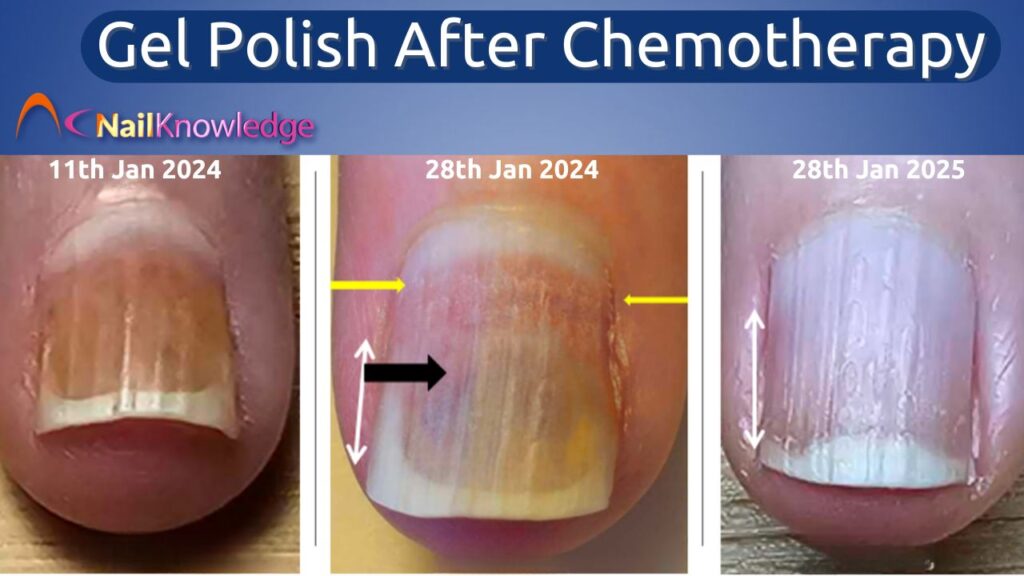¿Cuándo es seguro volver a hacerse la manicura?
Chemotherapy is a battle, a test of resilience, and for many, a transformative journey. But alongside its life-saving power, it takes a toll on the body, and nails are no exception. Brittle, ridged, discoloured, or even lifting from the nail bed, these are common post-chemo concerns. And now that the treatment is over, a question arises: when is it safe to indulge in a little self-care and wear gel polish after chemotherapy? Let’s break it down.
Understanding Chemo’s Impact on Nails
Your nails are like a reflection of what’s happening inside your body. Chemotherapy doesn’t just attack cancer cells, it affects fast-growing cells everywhere, including those responsible for nail growth. That’s why many people notice their nails becoming weak, peeling, or developing dark streaks during treatment.
Some chemo drugs are harsher on nails than others. Taxanes, for example, are notorious for causing nail damage. In some cases, nails may even separate from the nail bed (a condition called onycholysis), it’s also possible that chemotherapy toxins in the blood leak from the nail bed where the weakest blood capillaries are and that’s not only extremely painful its dangerous for the nail tech. Given all this, it’s understandable why doctors often advise against wearing esmalte en gel during treatment, your nails need to be carefully monitored especially for color changes – and need be, given time to heal. Not doing so is plain foolish!
Por qué el lecho ungueal es especialmente vulnerable durante la quimioterapia

1-1: Leakage of chemotherapy through the capillaries of the nail bed.-2: Start of healing process the nail bed is still irritated and the nail plate is being forced out of the paronychium cup due to oedema.
1-3: Almost full recovery of the nail bed – where the little white arrow is the nail bed is still showing signs of irritation.
When nailbeds are affected by leakage of chemotherapy because the blood capillary’s get damaged, the recovery of those capillary’s can be a long, hard, ugly road and nail hygiene is paramount to stop any secondary infections from taking place. When oedema forces the nail plate out of the paronychium cup the worst thing you can do is apply any or all artificial nail products, the nail plate needs to be handled in such a way that the nail plate remains flexible and if need be a non-stick dressing (soft foam bandage) can be applied to stabilize the nail plate. Patients can also experience neuropathic symptoms that can be excruciating and again DO NOT do anything to the nails apart from good nail hygiene and maintenance and keep the free edge short.
Uñas después de la quimio: Por qué la recuperación es diferente para cada persona
But post-treatment? That’s when things get a little tricky. While the urge to get back to normal is strong, patience is key when it comes to your nail health.

2-4: 14 months after the end of chemotherapy – the nail bed starts to show signs of irritation and onycholysis.
2-5: 14 months and 21 days later, onycholysis is extreme and client is experiencing pain where the nail bed is red, there are no signs of hyperkeratosis or blood splinters – just clear clean detachment of the nail plate from the nail bed.
2-6: Although at the right lateral nail wall of this same finger it ‘looks like‘ it could be a blister, there are no signs of blistering, hyperkeratosis or extreme desquamation of nail bed cells when we look down the barrel of the nail.
We tested these nails for fungi or Candida, these tests were negative. Client does not use any nail coatings and is almost obsessive about hand and nail care. There is no conceivable reason from the outside for this nail plate detachment – None, but … something is happening and because of this clients medical history we have referred her back to the Oncologist and Dermatologist.
When Nail Recovery Doesn’t Go as Expected
With all our knowledge we cannot find a conceivable reason for this sudden nail bed irritation and onycholysis – if you don’t have this knowledge and your client just wants pretty nails you MUST refuse service – you will not be insured for any or all damage that may or may not be caused by applying any or all artificial nail products.
It Ain’t Over Till It’s Over
Sometimes nails need more time. After your immune system has been broken down by chemo or immune therapy, the slightest little thing can affect the nail unit. Do not use any artificial nail products on nails showing any onycholysis or nail wall separation. Let the specialists that the client is still seeing find the cause and wait, your client will thank you for it.
Its tough, your client has survived the hell that is cancer, he/she lost all her hair, her body swelled in all directions, her nail plates were hanging off, her operations were hard, the scars visible – he/she got through all of that and all he/she wants is to be ‘normal’ to look good, to get on with his/her life – how much harm can pretty nails cause?
We spent 14 months fighting to hold on to these nail plates – if we do something now that compromises them in the name of beauty and this client would get a secondary fungal or bacterial infection she could still lose her fingers – That’s not what were here for – we are educated nail techs, nothing more and nothing less.
The problem is every client is different – There is one guarantee ***No todos los cuerpos reaccionan de la misma manera a las mismas terapias y no todas las terapias reaccionan de la misma manera en cuerpos diferentes***.
El cuidado de las uñas durante y después de la quimioterapia debe limitarse únicamente a manicuras sencillas, pasivas y no invasivas.
Some people don’t suffer too much, others almost loose their minds because the neuropathic pain in their nail units is unbearable.
Regla nº 1: NO CAUSAR DAÑO
- If you don’t know what your doing – don’t do it
- If you’re not sure you should do it – don’t do it
- If you’re worried about doing it – don’t do it
- If your client says – its ok, my oncologist said its fine without a letter of approval – don’t do it
- If your clients oncologist says a passive manicure is ok with a letter of approval and you want to grab your efile with a safety bit – don’t do it
¿Cuándo se puede volver a usar el esmalte de gel?
There’s no universal rule for when you can safely start using esmalte en gel después de la quimioterapiapero la mayoría de los expertos recomiendan esperar al menos de tres a seis meses después del último tratamiento. ¿Por qué? Porque aunque la quimio esté fuera de tu sistema, sus efectos perduran. Tus uñas pueden estar aún frágiles y posiblemente más sensibles, y añadir esmalte de gel demasiado pronto puede causar daños involuntarios.
For some, nails bounce back fairly quickly. Others may take a year or more to fully regain strength. A good rule of thumb? If your nails still feel weak, thin, or ridged, it’s best to hold off. Let your (clients) body recover first before exposing your (clients) nails to gel polish application and removal.
Cómo saber si tus uñas están listas
Antes de volver al esmalte de gel, fíjate en estos signos:
- Fuerza – Can your nails withstand gentle pressure without bending or splitting?
- Sin separación – Is the nail firmly attached to the nail bed with no separation?
- No levantar las paredes laterales – if the nails are not in the paronychium cup do not use any artificial nail products.
- Color saludable – Have any dark streaks, yellowing, or discolouration faded?
- Sin crestas ni peladuras excesivas – Are your nails strong enough to hold polish without it chipping quickly?
If you’re still seeing signs of damage, don’t rush. Instead, focus on strengthening y o mejorar primero las uñas.
Cómo preparar las uñas para el esmalte de gel después de la quimioterapia
If you’re confident that your nails are ready, taking the right precautions will help you avoid setbacks. Here’s what you should keep in mind:
1. La hidratación no es negociable
Las uñas después de la quimio están sedientas. Manténgalas hidratadas con un aceite para cutículas. Dehydrated nails are more prone to peeling and snapping, chemotherapy or immunotherapy can cause nail plates to become thinner or more brittle, so this step is crucial. There are some amazing products in the market anno 2025 – something containing 10% Urea is perfect as are all high quality nail & skin oils, avoid oils and or lotions with artificial colourings or perfume as your client may well be more sensitive to irritations until he/she is fully recovered.
2. Avoid Buffing
Hablando de pulir. Tus uñas ya son delgadas después de la quimio, y pulirlas las hará aún más débiles. No pulir las placas de las uñas antes o después de la quimioterapia o inmunoterapia..
3. Cuidado con la mudanza
Gel polish removal can be harsh on delicate nails. Acetone soaks can dry out the nail plate, leading to further brittleness. Instead of soaking for long periods, use a gentle removal method with foil wraps and plenty of high quality nail & skin oil afterwards.
Alternativas al esmalte de gel mientras tus uñas se recuperan
If your nails aren’t quite ready for gel but you still want a polished look, consider these alternatives:
- Tratamientos de refuerzo – Products with keratin or biotin can help rebuild nail strength without the risk of damage from gel. IBX is a real option if used as advised and only after professional training.
- Envolturas de uñas – These provide colour and durability without the need for UV curing or harsh removal processes. Nail Wraps can be totally gorgeous and if used properly will cause no damage take special care to remove them properly.
- Nail Polish or Nail Varnish – take the time to apply it well, use a new base coat and it can last for days but if it doesn’t you can remove it with a good nail polish remover or acetone – this is important, by any or all signs of change in the health of the nail plate or nail bed we need to see whats going on asap.
Cuándo buscar asesoramiento profesional
If your nails remain weak, discoloured, or painful long after finishing chemo, it may be worth consulting a dermatologist or an Oncology Hand Care Specialist. In some cases, nail damage can be a sign of an underlying issue, such as persistent inflammation or a fungal infection. Actually post chemotherapy you are more susceptible to fungal infections especially White Superficial Onychomycosis and Candida.
Reflexiones finales: Abrazar el viaje
Getting back to normal after chemo is a process, and that includes nail care. While the temptation to dive straight back into gel polish after chemotherapy is understandable, patience is the name of the game. Give your nails the time they need to recover, nourish them with care, and when they’re ready, enjoy that well-earned manicure with confidence.
After everything you’ve been through, your nails deserve just as much care and attention as the rest of you. Take it slow, listen to your body, and when the time is right, you’ll be back to flaunting those perfectly polished nails in no time.


